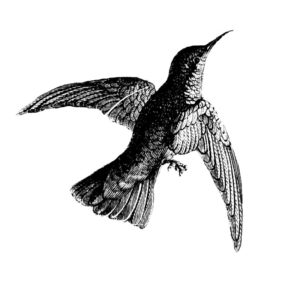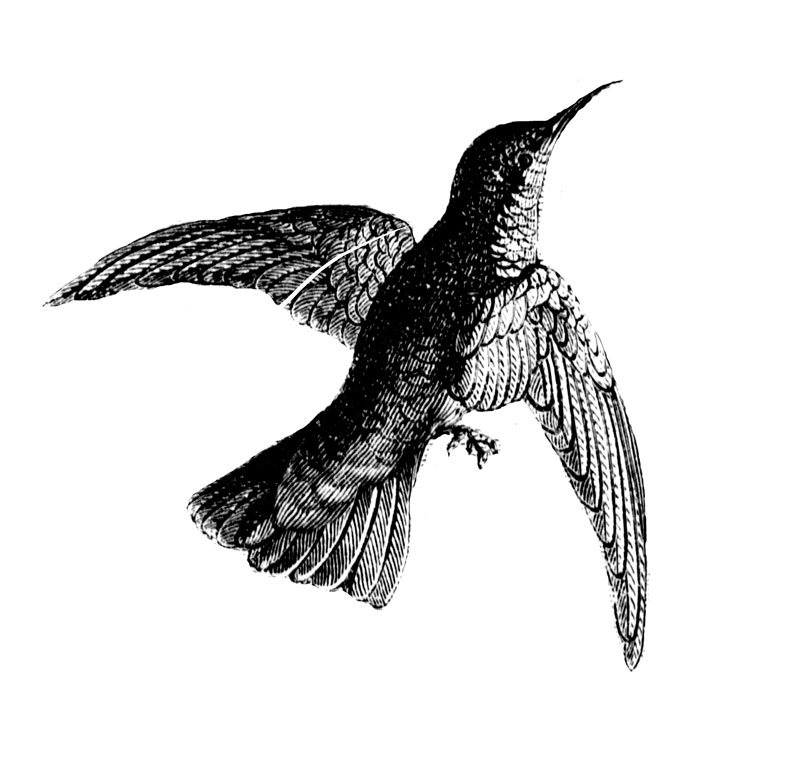By Tina Mitchell
Glittering, feathered jewels of green, orange, dark purple and red charge and chase each other with long, thin, pointed daggers, sputtering like electric sparks. A scene from an animated science-fantasy movie? No, it’s July at Central Colorado’s hummingbird feeders and wildflowers.
When I start a species account, I often think “What’s interesting about this species?” With hummingbirds, though, what isn’t interesting? The smallest of all birds, hummingbirds weigh between 0.1 and 0.3 ounces – about the same as five to 15 M&M’s. Their eggs, usually laid as a pair, are the size of a jelly bean. Although they are known for nectar feeding, they also eat small insects and spiders. They even use spider webs and cocoon silk in building their thimble-sized nests, so that they expand as the nestlings grow. These tiny birds hover seemingly endlessly in the air, as well as fly forward, backward, side to side and even upside down for short distances. Their “humming” wings move faster than the eye can discern – for Colorado’s species, that’s around 50 beats per second – and can propel these birds up to 60 m.p.h. Their hearts pump 1,250 times per minute when they are flying; even at rest, their hearts still race at 250 beats per minute. The oldest recorded Rufous Hummingbird had clocked eight years and 11 months on its ticker. Imagine how many times that heart beat! Yet when temperatures fall, hummingbirds can enter torpor, where their heart rates can drop to 50 beats per minute and their body temperatures fall from about 110 degrees F to 55 degrees F. As long as they have stored sufficient energy, they can emerge from torpor unscathed when the mercury rises. Measured in body lengths, hummingbirds make the longest migration known in the bird world. Rufous Hummingbirds routinely fly more than 2,500 miles from their wintering grounds in Mexico to their breeding areas stretching from Oregon, Idaho, Montana and northward. In effect, they travel 49,000,000 body lengths twice a year. A Rufous Hummingbird banded in Tallahassee, Florida, was recaptured six months later at Prince William Sound in Alaska – roughly 3,530 miles away, marking the longest documented hummingbird migration route to date.
[InContentAdTwo]
The 17 species that have bred in the U.S. and Canada represent only about five percent of the more than 320 hummingbird species in the western hemisphere. Two species breed in Colorado: Broad-tailed Hummingbird and Black-chinned Hummingbird. If you see the males of either species in a perfect light, you’ll see a flash of diagnostic color from the gorget (the feathers at the throat) – a brilliant rose-red for Broad-taileds and a deep purple for Black-chinneds. In a less-than-perfect light, the throats just look dark. (Females of these species can be very challenging to tell apart.)
 In July, two other species regularly pass through central Colorado, migrating south. In strong light, a male Rufous Hummingbird glows like a bright copper penny, with his cloak of brilliant orange and a flashy iridescent red-orange gorget. At feeders, he vehemently chases all comers, uttering a rapid, buzzy, pugnacious “ZEE-chuppity-chup.” (Okay. On paper, that doesn’t seem all that menacing. But in live action, especially if you’re a hummingbird, it packs a much bigger punch.) The Calliope Hummingbird (pronounced “kuh-LYE-uh-pee,” as in the musical organ heard at merry-go-rounds) is – believe it or not – quite noticeably smaller than the other hummingbirds in our area. Our feeders have stationary perches, rendering the Calliopes even easier to pick out; unlike other likely species, these midgets have to stretch their necks waaaayyyy up to reach the feeding port from the perch. An adult male has a greenish back and distinctive magenta feathers streaking down both sides of his white throat, making him look as if he were perpetually facing into a headwind.
In July, two other species regularly pass through central Colorado, migrating south. In strong light, a male Rufous Hummingbird glows like a bright copper penny, with his cloak of brilliant orange and a flashy iridescent red-orange gorget. At feeders, he vehemently chases all comers, uttering a rapid, buzzy, pugnacious “ZEE-chuppity-chup.” (Okay. On paper, that doesn’t seem all that menacing. But in live action, especially if you’re a hummingbird, it packs a much bigger punch.) The Calliope Hummingbird (pronounced “kuh-LYE-uh-pee,” as in the musical organ heard at merry-go-rounds) is – believe it or not – quite noticeably smaller than the other hummingbirds in our area. Our feeders have stationary perches, rendering the Calliopes even easier to pick out; unlike other likely species, these midgets have to stretch their necks waaaayyyy up to reach the feeding port from the perch. An adult male has a greenish back and distinctive magenta feathers streaking down both sides of his white throat, making him look as if he were perpetually facing into a headwind.
In addition to the color and size differences, the species produce different wing noise. The male Broad-tailed’s wings send off a cricket-like trill that is nearly unmistakable. The Black-chinned’s lower sound reminds me of the lumbering June bugs that used to hurl themselves against the screens when I was a kid in the Midwest, while a Calliope’s wings sound more like a bumblebee to me. July is the perfect time to find your own comparisons among these species.
Add the two migrant species to the mix of central Colorado’s breeding adults with their newly fledged kids, and crazed zipping and zooming can erupt near any food source. Stand back and let the hummingbird wars of July begin!
After a quarter-century in Colorado, Tina and her family recently migrated to Southern California, where she’ll spend the next quarter-century trying to remember that the mountains lie to the east.



